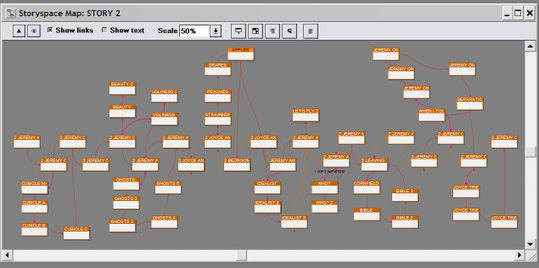I’m not sure if I’m discovering new things or floundering badly (Look ma, I can drive with my eyes closed!) but Steve Ersinghaus has been bringing up some great issues as he takes on Paths.
It’s become obvious to me that in first preparing this narrative* I didn’t quite understand the way links can work though I understood how they do. I’m fixing and rearranging and improving the connections I’ve made as I work with the actual program of Storyspace. That’s to be expected; I knew at the time I wrote Paths that I was writing for hypertext possibilities (without, as I say, fully comprehending them) but had the necessity of book pages in traditional form to deal with, and that changed the plan somewhat. Or rather, the method, since the plan is still intact.
Steve says:
"I don’t like the idea of providing freedom to the reader, even though exploration may matter. I like the idea of allowing the work to decide its possible internal modifications and adjustments. It’s a massive struggle."
Well I’m all for taking back control, but I understand what he is saying here. The work as a whole is a cohesive collage; each image must stand on its own, yet relate to another: Now that’s Great Aunt Minnie, she’s Gertie’s sister who’s right over there next to her brother Albasilver. If the reader follows a diagonal pattern across the map and completely misses the wayward daughter Pearl, he’ll never know how the whole Clam family got started one moonlit night on a couple of beers and be completely confused at the photo of little Jimmy Clam in the lower left-hand corner.
So I would think that while I am trying to touch story points at certain levels that grant access to possibilities, I don’t want to allow total random wandering. I do want to make sure that by following any one of the four paths, by the end of that path, the reader has a good idea of the basic premise of what happened, and what may be happening, as well as what could have happened. Any of the stories should be revealing that much–though not completely by themselves, but with the help of the allowed sidetracks into one of the others and the vision it reveals.
I do wonder whether I am off on a "Look ma!" trip, or whether I should read and incorporate some of Mark’s theories into this piece. I realize that you have to know and understand the rules before you break them–I’m a strong advocate of that in writing, but I’m also aware that I’m too easily swayed sometimes. It will be interesting to see what Steve has to say about the structure once he’s further into it; I trust him to be honest and if he says I’ve led readers into and then left them lost in the woods, or put up fences while they weren’t looking, then I’ll know that the hypertext form does have some rules that need to be followed. And I’d better learn them.
*I myself vacillate between calling Paths the singular "narrative" and the multiple "stories," because of its nature. In the end, I think that it is a single story as there may be only one truth, and that is what the reader has decided it to be.


 The Lost Children: A Charity Anthology
The Lost Children: A Charity Anthology